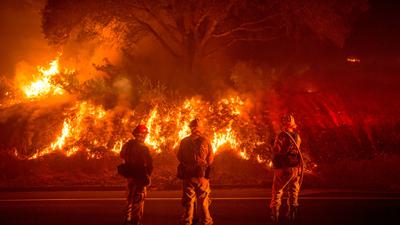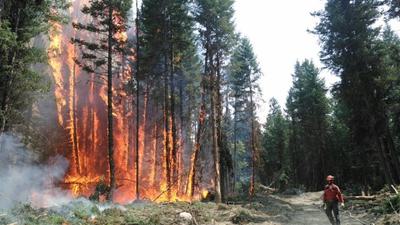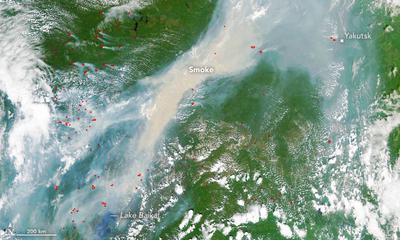On a single hot, dry day this summer, an astonishing 140 wildfires leapt to life across British Columbia. “Friday, July 7 was just crazy,” says Mike Flannigan, director of the wildland fire partnership at the University of Alberta. A state of emergency was declared. By the end of summer, more than 1,000 fires had been triggered across the Canadian province, burning a record nearly 3 million acres of forest—nearly 10 times the average in British Columbia over the last decade. As the fires got bigger and hotter, even aerial attacks became useless. “It’s like spitting on a campfire,” says Flannigan. “It doesn’t do much other than making a pretty picture for the newspapers.”
Forest fires are natural. But the number and extent of the fires being seen today are not. These fires are man-made, or at least man-worsened.
“Evidence is becoming more and more overwhelming,” says Flannigan, that climate change is spreading fires around the world. Globally, the length of the fire weather season increased by nearly 19 percent between 1978 and 2013, thanks to longer seasons of warm, dry weather in one-quarter of the planet’s forests. In the western United States, for example, the wildfire season has grown from five months in the 1970s to seven months today.
The number-crunching now shows an increased risk for fire on nearly every continent, says Flannigan, though most of the work has focused on North America, where there is a larger pot of funding for such research. In the western U.S., where fires ravaged Oregon this summer, the annual burned area has, on average, gone from less than 250,000 acres in 1985 to more than 1.2 million acres in 2015; human-caused climate change has been blamed for doubling the total area burned over that time.
Similarly, for fire-ravaged British Columbia, an analysis from this July estimates that climate change has made extreme fire events in western Canada 1.5-6 times more likely.
So how much worse are things set to get?
Pinning any specific environmental event on climate change is a tricky business, though the science of weather attribution has grown in leaps and bounds over the past decades. Individual wildfires are still near the bottom of the list of things that can easily be pegged to a changing climate, thanks to all the other factors in the mix. If people break up forests into smaller chunks through logging or agriculture, that can limit the spread of forest fires; on the other hand, some trees burn faster than others (younger trees are greener, so burn slower), and shrubs under a tree canopy can make fire more intense. A particularly rainy year can paradoxically increase fire risk if the rain comes in springtime, by boosting the volume of vegetation available to burn later in the season. Natural weather patterns like El Niño can have a dramatic effect on precipitation, and so on fire.
“If we have higher temps, we have a greater probability of fire starting, fire spreading, and fire intensifying.”
Fire management is also a big contributor, leading to some surprising trends in the world’s total burn area. Globally, wildfires actually decreased by about 7 percent over the first half of the 20th century, probably due to increased efforts in places like the U.S. to stamp them out (though fires have gone up since the 1960s in the western U.S., the burned area there was actually just as bad in the early 1900s, before fire-fighting efforts kicked into high gear). The last half of the 20th century saw that global trend reverse, with the area burned bumping up by 10 percent, thanks in part to an increase of fires set in the tropics to clear land. The past 18 years saw burned area decline again, by nearly 25 percent, largely due to agriculture taking over fire-prone grasslands in areas like the African savanna.
All that makes it hard to pin down why any one given fire happened, or even why any one region might be seeing more fire, though a handful of such attribution studies have been done. Nevertheless, there is still a clear link between general climate trends — in particular warming temperatures — and an increased risk for fire. “If we have higher temps, we have a greater probability of fire starting, fire spreading, and fire intensifying. That’s basic physics,” says Stefan Doerr, a geographer at Swansea University in Wales and a chief editor of the International Journal of Wildland Fire. Warm air holds more water. So as air temperatures climb, the thirsty air sucks more moisture out of vegetation, making it better firewood. Warmer temperatures also lead to more lightning, which sparks some destructive wildfires — each degree of warming is thought to increase strikes by about 12 percent. Earlier snowmelts make fire seasons longer. And a warmer world is a windier world, bringing the potential to further fan flames.
British Columbia had more than 1,000 wildfires this summer, including this one in the Cariboo region. B.C. Wildfire Service
Though climate change might also bring more rain to some areas, you need a lot of water to offset the impact of temperature: In Canada, one study shows, you need about 15 percent more rain to offset the increased fire risk from a 1-degree Celsius rise in heat. Climate models call for something on the order of a 10 percent increase in rain alongside 1 degree of warming in Canada — not enough to counteract the drying effect.
Last year, John Abatzoglou of the University of Idaho published a paper showing that human-caused warming since the 1970s has been responsible for about half of the increased dryness of western U.S. forests over the last 30 years. And the drier it was, the more forest burned. “It’s a complicated issue,” says Abatzoglou. “But the way we see it, how dry fuels are explains about three-quarters of year-to-year variability [in fires].” By the train of logic followed by Abatzoglou and his colleagues, climate change is to blame for doubling the area that burned in the western U.S. between 1984-2015, adding an extra 10 million acres of charred trees.
The Intergovernmental Panel on Climate Change’s last report, in 2014, could only pin down strong evidence of major impacts on forest fires due to climate change in three areas: Alaska, some parts of the Mediterranean, and eastern Africa. But that was a few years ago and, fire researchers argue, it was a conservative view even at the time.
The effects of warming temperatures on fire are being felt widely. Even Greenland has had a significant number of fires this year.
Today, researchers agree the effects of warming temperatures on fire are being felt widely. Even Greenland has had a significant number of fires this year, notes Flannigan, who ticks off the many areas where climate change is having, or will have, an impact: “Alaska and all boreal Canada is already seeing change, and it’s going to continue. Western U.S., for sure. Southeastern U.S., maybe. Mediterranean, yes. Scandinavia, possibly. Sweden had a big fire in 2014 that really blew them away. Chile had the worse fire season on record by far. Australia, definitely. China, in the northern areas, yes.”
Siberia is seeing its worst fires in 10,000 years, probably due to extreme temperature rises in that region. Interestingly, the new climate and all this fire looks set to change the types of trees growing in the Siberian landscape, to more fire-resistant species like deciduous conifer larch; researchers think fires there may actually level out.
Australia, which has had horrific wildfires in recent years, added a new category at the upper end of its fire risk scale in 2009: “catastrophic.” But so far, scientists say, it is difficult to say if, or how much, climate change is responsible for that. The fire risk in Australia is very strongly affected by natural climate patterns like El Niño, and populations are moving into higher risk areas. “Human interaction is probably more important than climate change,” says Doerr. Nevertheless, climate change is expected to bring warmer, drier weather to some parts of Australia, extending the fire season and increasing the number of days where risk is particularly high.
A satellite image shows dozens of wildfires burning across Siberia on June 23, 2017. NASA Earth Observatory
While it’s clear that a warmed world will likely be a more fiery one, the specifics are hard to pin down. In general, global climate models show a patchy map of future fire risk, with the areas of increased risk outweighing areas with a decreased chance of fire. The areas of increased hazard are scattered widely across the high latitudes, like Alaska, where changing climate tends to boost vegetation growth. Areas of decreased risk are mainly in the tropics, where rainforests, for example, might see more rain. One 2008 study predicted that the area burned across Alaska and Canada might increase 3.5–5.5 times over 1990 levels by 2100.
The increased risk for fires means we need to change how we manage them, argue Doerr and others. Since World War II, North America has largely been focused on fighting a war on wildfire, military-style. In the U.S., a 2016 paper reports, aggressive fire suppression policies mean that only 0.4% of wildfires are allowed to burn; the rest are tackled by firefighters. But the strategy of putting out every fire only works when there are fewer fires, and when they happen in cooler, wetter years. Pumping ever-more money into firefighting tends to have only a small effect: one Canadian study showed that to meet a 15 percent increase in fire load, officials would have to more than double their firefighting budgets.
More fires mean more carbon dioxide emitted into the atmosphere and more smoke, with its attendant health problems.
One alternative is to allow more fire on the landscape, to eat up the excess fuel and fragment the forests into smaller burnable chunks. When you get more than 100 fires lit in a single day, as happened in British Columbia on July 7, there is no option but to do triage and assess which fires to attack and which to leave: “There was no way they had enough crews for them all, so they had to choose,” says Flannigan. But that’s what they should be doing all the time, he adds, using better models to predict fire growth and assess each fire’s potential to harm valuable assets like watersheds and buildings. Flannigan is working to build artificial intelligence algorithms that can better predict the hot, dry, windy days that are particularly conducive to fire spread. “Allowing more fire on the landscape is good,” says Flannigan, so long as there are the resources and warning systems to attack the threatening ones.
Other sensible options include restricting the type of vegetation planted near urban areas, and using prescribed burning and logging to intentionally break up the landscape. But integrating all the different jurisdictions and companies involved with land management is a big task that’s easier said than done, researchers note. The 1988 fire that burned half of Yellowstone National Park, Flannigan says, did a lot to help shift attitudes about fire from seeing it as evil to natural: Scientists used it as a springboard to talk about fire’s healthy and rejuvenating effects on a landscape. But official policies did not change much, and there’s still a long way to go in shifting opinions, he says.
Whatever actions are taken, in the face of climate change we will have to accept the idea of more fire in our lives. That means more carbon dioxide emitted into the atmosphere as trees and vegetation burn; more smoke, with its attendant health problems from pneumonia to heart disease; more fire retardant chemicals in our landscape and watersheds; more poisons like mercury spread from peatland and forest fires; and more black particulates darkening the planet’s ice caps.
“We do expect to see more years like this one,” warns Abatzoglou.





